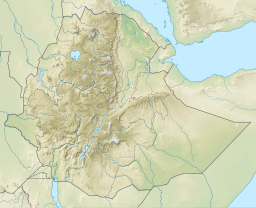Addi Hilo
Appearance
| Addi Hilo | |
|---|---|
 | |
| Coordinates | 13°26′34″N 39°34′00″E / 13.44277616°N 39.56654435°E |
| Type | Freshwater artificial lake |
| Basin countries | Ethiopia |
| Surface area | 0.025 km2 (0.0097 sq mi) |
| Water volume | 0.108806×106 m3 (88.210 acre⋅ft) |
| Surface elevation | 2,310 m (7,580 ft) |
| Settlements | Kwiha |
Addi Hilo is a reservoir located in the Inderta woreda of the Tigray Region in Ethiopia. The earthen dam that holds the reservoir was built in 1998 by SAERT.[1]
Dam characteristics
- Dam height: 11.4 metres
- Dam crest length: 171 metres
- Spillway width: 1 metre
Capacity
- Original capacity: 108 806 m³
- Dead storage: 4328 m³
- Reservoir area: 2.5 ha
In 2002, the life expectancy of the reservoir (the duration before it is filled with sediment) was estimated at 9 years.[1]
Irrigation
- Designed irrigated area: 9 ha
- Actual irrigated area in 2002: 9 ha
Environment
The catchment of the reservoir is 0.72 km² large, with a perimeter of 3.34 km and a length of 1210 metres. The reservoir suffers from rapid siltation.[2] The lithology of the catchment is dominantly Agula shale and little Mekelle dolerite.[1] Part of the water that could be used for irrigation is lost through seepage; the positive side-effect is that this contributes to groundwater recharge.[3]
References
- ^ a b c De Wit, Joke (2003). Stuwmeren in Tigray (Noord-Ethiopië): kenmerken, sedimentatie en sediment-bronnen. Unpub. M.Sc. thesis. Department of Geography, K.U.Leuven.
- ^ Nigussie Haregeweyn, and colleagues (2006). "Reservoirs in Tigray: characteristics and sediment deposition problems". Land Degradation and Development. 17: 211–230. doi:10.1002/ldr.698.
- ^ Nigussie Haregeweyn, and colleagues (2008). "Sediment yield variability in Northern Ethiopia: A quantitative analysis of its controlling factors". Catena. 75: 65–76. doi:10.1016/j.catena.2008.04.011.

